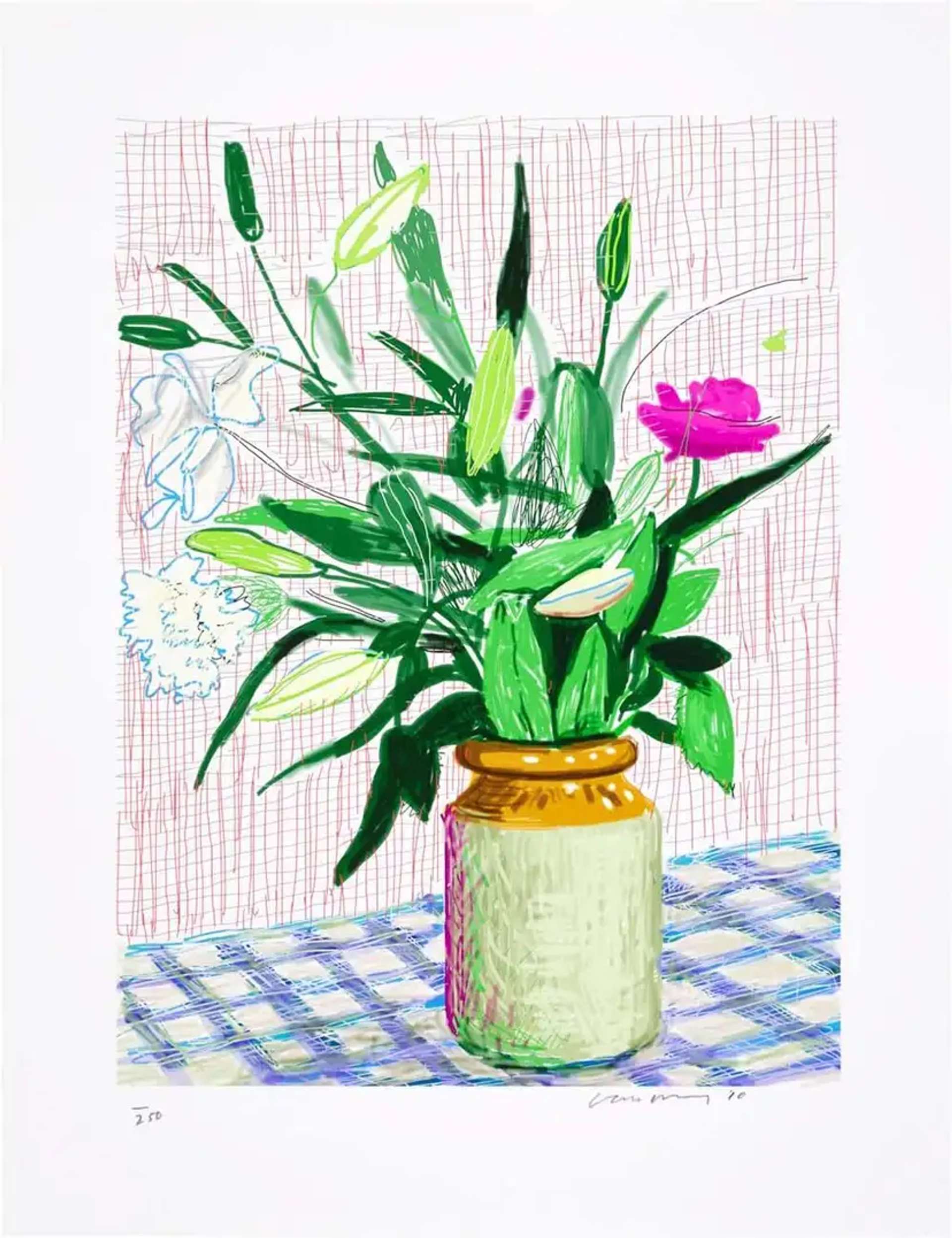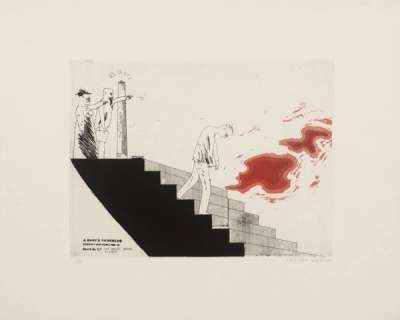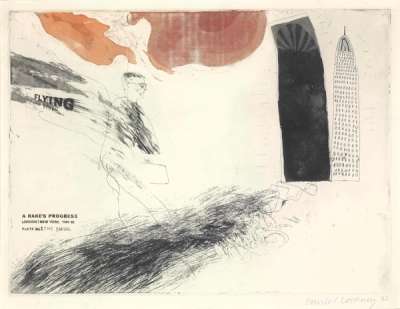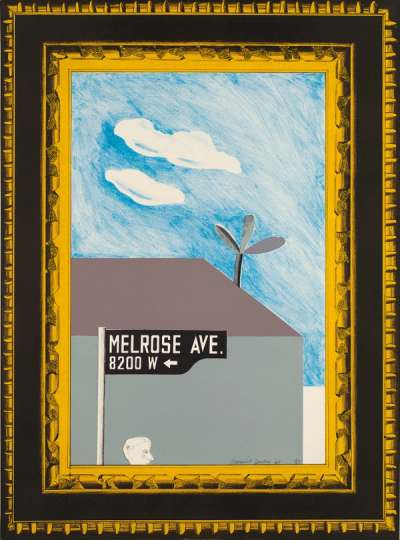 Picture of A Simple Framed Traditional Nude Drawing © David Hockney 1965
Picture of A Simple Framed Traditional Nude Drawing © David Hockney 1965
David Hockney
631 works
From his impactful etchings in the 1960s to his contemporary digital drawings, David Hockney's career has seen a dynamic evolution, continuously pushing the boundaries of creativity and expression. Beginning in an era where Pop Art and Modernism were at the forefront, Hockney carved a niche for himself with works that vibrated with the energy and ethos of the times. His early pieces, marked by a daring use of colour and form, laid the groundwork for a career characterised by constant evolution.
 Home © David Hockney 1969
Home © David Hockney 1969Tracing David Hockney's Artistic Awakening
Hockney’s formative years, a period steeped in exploration and rich artistic ferment, laid the foundation of a career that would later blossom into a mastery of colour and form. Hockney's journey began in the post-war era, a time when the art world was ripe with transformation, and young Hockney was poised at its cusp, ready to imprint his vision upon it.
Born in 1937 in Bradford, England, Hockney's early life was set against a backdrop of industrial landscapes, a stark contrast to the vivid hues that would later populate his canvases. His journey into the art world commenced with his education at the Bradford College of Art. Here, Hockney's raw talent began to take shape, sculpted by the rigours of academic training and his burgeoning passion for art.
However, it was during his time at the Royal College of Art in London that Hockney's style began to crystallise. Amidst the cultural melting pot of the early 1960s, Hockney was exposed to the advent of Pop Art. This new form, with its bold colours, commercial imagery, and rejection of elitist traditions, struck a chord with Hockney. He began to experiment, combining the techniques of the old with the spirit of the new.
Hockney's time at art school was not just a period of technical and stylistic development; it was a journey of self-discovery. As a young, openly gay man in a time of significant societal constraints, Hockney's art became a conduit for exploring and expressing his identity. His work from this period is imbued with a sense of exploration and questioning, a visual diary chronicling his experiences and emotions in a world that was often unaccepting and harsh.
The seeds planted during these years at art school would grow into the distinctive style that Hockney is celebrated for today: a style that is at once deeply personal and universally appealing, a style that continues to challenge and enchant art lovers around the globe.
 Doll Boy © David Hockney CC BY 2.0
Doll Boy © David Hockney CC BY 2.0 Pablo Picasso and Francis Bacon’s Influence on David Hockney
Hockney’s early paintings, characterised by a playful yet poignant exploration of personal and semi-autobiographical themes, were marked by a distinct use of texture and a developing palette that hinted at the vibrant explosions of colour that would later define his work. The influence of his peers and mentors at the Royal College, including painters like Francis Bacon, cannot be overstated. Their emphasis on emotional depth, personal narrative, and the human figure, left a critical mark on Hockney's artistic psyche.
Arguably, if there’s any work we can look to for evidence of Bacon’s influence, it might be Hockney’s Doll Boy. Though not as daunting and disfigured as Bacon’s renderings, Hockney’s composition in this work certainly mirrors Bacon’s approach with lesser defined facial features that are a bit more melancholy.
 A Grand Procession of Dignitaries in the Semi-Egyptian Style © David Hockney CC BY 2.0
A Grand Procession of Dignitaries in the Semi-Egyptian Style © David Hockney CC BY 2.0Following suit of the despair, we can also see a connection to Picasso’s Rose Period in works like A Grand Procession of Dignitaries in the Semi-Egyptian Style, though inspired by a Cavafy poem, has a similar undertone to the characters in Picasso’s Family Of Saltimbanques.
The works of the Old Masters like Pablo Picasso resonated with him, offering a classical foundation upon which he could build. Yet, it was the more contemporary waves that truly stirred his artistic soul. Abstract Expressionism of the time, a movement that celebrated the chaotic and the visceral, seemed to echo Hockney's own internal creative wrestlings.
David Hockney in the 1960s: A Fusion of Pop Art & Modernism
In the 1960s, Hockney emerged as a transformative figure in the art world, skillfully blending the striking visuals of Pop Art with the reflective depth of Modernism. This era was crucial in shaping his artistic identity, evident in works like A Bigger Splash. This painting, capturing the simple act of a splash in a pool, exemplified the vibrant, attention-grabbing style of Pop Art. Yet, it also conveyed a sense of isolation and introspection, a Modernist touch that delved into the nuances of the human experience. His series of Swimming Pools, vivid in colour and simple in form, further epitomised this fusion, combining the everyday imagery of Pop Art with a contemplative, almost detached perspective, typical of Modernist themes.
Throughout the decade, Hockney's experimentation across different media, including his Photographs and printmaking, underscored his commitment to merging these two art movements. His work, reflective of the cultural and social ethos of the 60s, invites viewers into a transcendent dialogue, blending the vibrant with the contemplative, and firmly establishes Hockney as a pivotal figure in the modern art narrative.
Hockney’s Early Etchings and Lithographs
Hockney's Early Prints etchings and lithographs, often lesser-known yet equally significant facets of his artistic repertoire, offer a profound insight into the evolution of a master. Created during a period of intense experimentation and self-discovery, these works stand as crucial milestones in understanding Hockney's journey from a student of art to a connoisseur of visual storytelling.
Lithography, another medium Hockney explored during this period, allowed him a different kind of expressiveness. The lithographs, such as The Hypnotist MCA Tokyo, are bolder and more direct. Here, Hockney began to play with colour, albeit in a more subdued palette than his later works. These pieces are marked by a certain vibrancy and immediacy, reflecting Hockney's growing confidence and his willingness to push the boundaries of traditional art forms.
What is particularly striking about Hockney's early etchings and lithographs is their narrative quality. Each piece tells a story, whether it be a direct representation of a scene or a more abstract, emotional expression. This narrative thread is a precursor to the more explicit storytelling found in his later paintings, demonstrating Hockney's enduring interest in the power of stories and his ability to weave them seamlessly into his art.
Moreover, these early works exhibit a fusion of influences – from the Old Masters to contemporary trends – yet they are undeniably Hockneys. They display his burgeoning exploration into the themes of love, identity, and human experience, themes that he would continue to delve into throughout his career.
In examining Hockney’s early etchings and lithographs, we not only witness the genesis of his stylistic evolution but also gain a deeper appreciation for the breadth and depth of his genius. These works, though created in the early stages of his career, are critical in understanding the trajectory of Hockney's path and remain as relevant and compelling today as they were when they first emerged.
David Hockney’s A Rake’s Progress
A critical part of Hockney's early works is A Rake's Progress, a series of 16 etchings created in 1963, presenting a fascinating modern reinterpretation of William Hogarth's famed 18th-century series. Hockney's adaptation, while echoing the narrative style of Hogarth, brings a unique experimental flair to the fore, setting a new benchmark in visual storytelling.
Hogarth's original work, known for its satirical depiction of a young man's descent into debauchery and madness, served as a moralistic tale for its time. Hockney's take, however, diverges significantly in both theme and style. His series, inspired by his first visit to New York, replaces Hogarth's dense, detail-rich scenes with compositions that are strikingly minimalist and modern.
In A Rake's Progress, Hockney demonstrates a masterful control of etching, a skill he honed at the Royal College of Art. His confident use of this medium is evident in the way he simplifies and abstracts his scenes. Unlike Hogarth's character, Hockney's protagonist – often perceived as an avatar for the artist himself – navigates a world that is less about moral downfall and more about personal discovery and experience.
The series is notable for its use of colour, particularly the bold reds that punctuate the otherwise muted tones of the etchings. This colour choice is not only aesthetic, but serves to guide the viewer’s eye through the narrative. In works like The Arrival and The Wallet Begins to Empty, the red hues add a dramatic punch, while in others, like The Election Campaign, they draw attention to specific elements like text and signs.
Hockney's decision to leave backgrounds largely unadorned creates a sense of an 'unsettling non-place', a stylistic choice that focuses attention on the subjects and the few chosen objects within the scene. This minimalist approach not only contrasts with Hogarth’s detailed backdrops but also reflects a modernist sensibility, emphasising the isolation and introspection of the central figure.
Memorable Works of the 1960s: Hockney's Pivotal Creations
Naturally, one can only expect for this decade to feature one of Hockney’s most treasured muses throughout his career – Celia Birtwell. His 1969 etching of Celia showcases a quieter, more intimate side of this long-standing friendship, capturing her in a relaxed pose. As one observes the evolution of this series, it becomes evident that Hockney’s portrayals of Celia grew increasingly nuanced and emotionally resonant over time. This progression suggests a closer relationship between artist and muse, allowing Hockney to capture more personal aspects of her personality. His renderings progressively adopted a more vibrant colour palette and embraced cubist influences, infusing his depictions of Celia with dynamic energy and complexity. Hockney's journey with Celia reflects a deepening friendship paired with an evolving mastery in conveying character and emotion through his signature visual language.
Picture Of Melrose Avenue In An Ornate Gold Frame, part of Hockney's 1965 series A Hollywood Collection, we see Hockney’s fascination with trompe l’oeil techniques come to the forefront, masterfully blurring the lines between illusion and reality. The work, part of a fictional collection supposedly owned by a Hollywood star, was inspired by Hockney's encounter with a display of frames near the Gemini print studio and the 'artificial beauty' he perceived in the LA cityscape. It exemplifies Hockney's skill in creating a sense of artificial collection, a theme recurrent in art history, while also drawing on elements from his previous works.
Hockney's expertise in printmaking is evident in the way he handles varying elements in this piece. From the expansive wash of the sky to the stark black of the frame, each component is carefully crafted to play with surface and depth. This manipulation of the medium is not just a display of technical prowess but also an exploration of how visual elements interact within a confined space.
Cultural Reflections: Hockney’s Art in the Context of the 1960sCultural Reflections: Hockney’s Art in the Context of the 1960s
During a decade marked by social upheaval and the push for civil rights, Hockney's work resonated deeply with the burgeoning movements for sexual liberation and gay rights.
One of the most poignant examples of this cultural reflection is Hockney's Illustrations for Fourteen Poems by C.P. Cavafy. Published in 1967, the same year homosexuality was decriminalised in Britain, this series is a profound acknowledgment and celebration of gay love. Hockney's connection with Cavafy's poetry, known for its candid exploration of homosexual themes, allowed him to create visual narratives that were both deeply personal and universally resonant. The timing of this publication was not coincidental but a deliberate act of solidarity with a marginalised community.
Hockney's approach in this series was nuanced yet impactful. He utilised sparse compositions with largely blank or partially shaded backgrounds, where the fine lines and subtle details focused attention on the figures and their interactions. This minimalistic style lent a certain intimacy to the scenes depicted, emphasising the emotions and connections between the characters over their surroundings.
In The Dull Village, one of the prints from this series, was recognised for its cultural significance by being included in the British Museum’s A History of the World in 100 Objects series. Hockney's own reflections on the series highlight his intent to use his art as a form of advocacy, a subtle yet powerful form of activism through which he sought to defend and normalise his way of living.
Hockney’s portrayal of homosexual relationships was not solely about visibility; it was a political statement, a fight for recognition and acceptance in a world that was often hostile to such expressions. His art, in this context, was a broader cultural commentary. It mirrored the spirit of the 1960s – a spirit of rebellion, liberation, and the relentless pursuit of personal and artistic freedom.
Reflecting on Hockney’s Legacy of the 1960s
As we look back at Hockney's journey through the 1960s, it becomes clear that this decade was a revolutionary period that defined his legacy. Hockney’s work during these years stands as a vibrant testimony to his ingenious ability to weave together diverse elements. His fusion of Pop Art's bold imagery with Modernism's depth created a unique visual language that resonated deeply with the cultural and societal shifts of the era. These works, characterised by their vivid colours, emotional complexity, and narratives, not only mirrored the spirit of the 1960s but also foreshadowed the continued innovation and influence Hockney would have in contemporary art.
The ongoing fascination with Hockney's 1960s portfolio reflects not just a nostalgia for a bygone era but also an appreciation for art that transcends time, continually finding relevance and resonance in the modern day. This enduring interest in Hockney's early work underscores his remarkable ability to capture the zeitgeist while also offering timeless reflections on human experience and emotion. As we revisit these seminal works, we are not only reminded of Hockney’s impact on the art world but also of the universal and enduring nature of artistic expression.


























